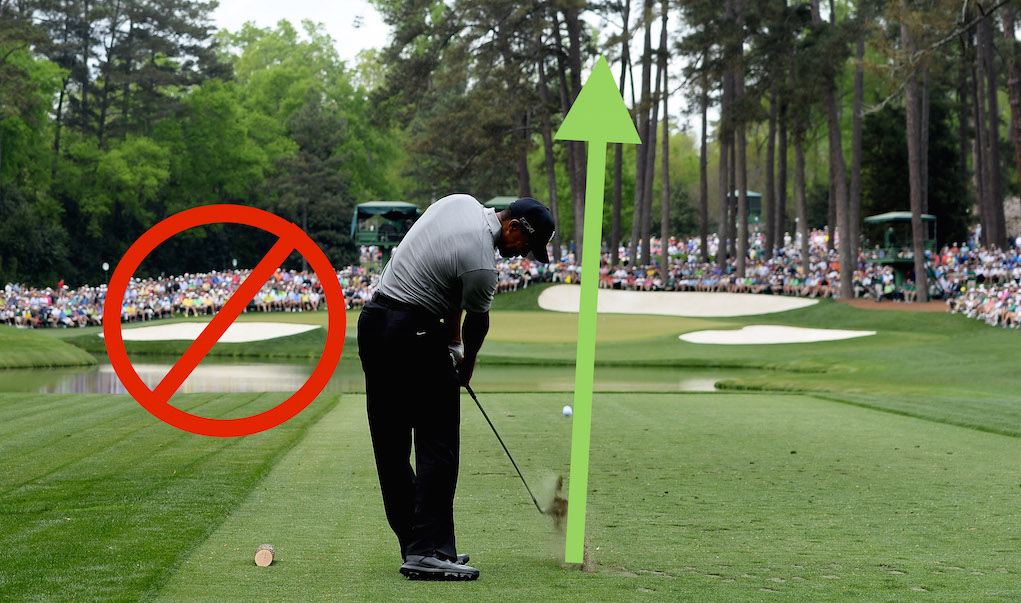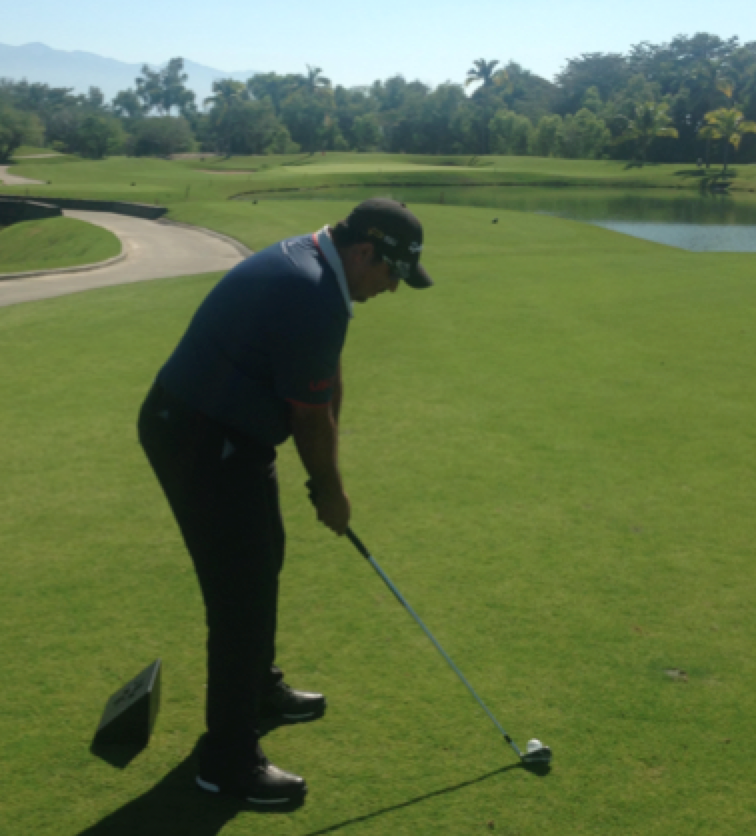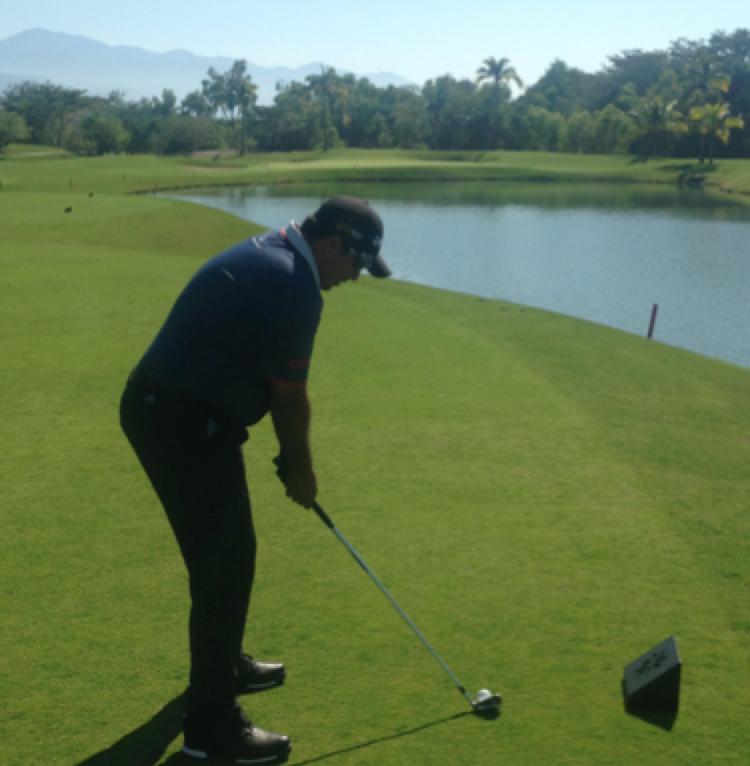Instruction
A Painfully Simple Strategy to Save Strokes on Par-3s

It’s amazing how complex we manage to make the game of golf. Remember, the goal is to get the ball in the hole in as few strokes as possible, no matter what. In this article, I want to give you a very simple par-3 strategy that will help you reduce mistakes and ultimately lower your scores.
Here at Vidanta we have a par-3 on the Norman Course that gives people fits. It plays between 160-170 yards, a mid iron for most golfers. The green runs parallel along the water’s edge and is bordered by water all along the right side. Any shot hit out to the right needs more distance to clear the water.
Think: What side of the tee box would you use, and what kind of shot would you hit?

Let’s discuss strategy. We want to ensure we accomplish three things:
- Stay out of the water.
- Hit the ball somewhere on the green.
- The only miss is in the bunker short and left of the green.
So how do we make these things happen more often?

If you tee up on the far left side of the tee box, as most people do on this hole, you make the hole play more difficult. It automatically brings the right side into play. So why do most people tee it up on the left side, then?
One reason is as simple as this: the cart path is on the left side of the tee. It’s an easy trap to fall into, but don’t do it! A few feet won’t matter much on the green, but it can have a drastic effect on the tee box.

In the photo above, you see a player who has walked over to the far right side of the tee box. He is aiming at the left side of the green, which will help him avoid the water on the right.
The secret to playing par 3’s is to ALWAYS tee your ball up on the side of the tee box closest to the trouble and aim away from it. Give it a try, and I promise you’ll be impressed with how much more often you find the green.
- LIKE445
- LEGIT56
- WOW16
- LOL12
- IDHT4
- FLOP4
- OB4
- SHANK50
Instruction
The Wedge Guy: The easiest-to-learn golf basic

My golf learning began with this simple fact – if you don’t have a fundamentally sound hold on the golf club, it is practically impossible for your body to execute a fundamentally sound golf swing. I’m still a big believer that the golf swing is much easier to execute if you begin with the proper hold on the club.
As you might imagine, I come into contact with hundreds of golfers of all skill levels. And it is very rare to see a good player with a bad hold on the golf club. There are some exceptions, for sure, but they are very few and very far between, and they typically have beat so many balls with their poor grip that they’ve found a way to work around it.
The reality of biophysics is that the body moves only in certain ways – and the particulars of the way you hold the golf club can totally prevent a sound swing motion that allows the club to release properly through the impact zone. The wonderful thing is that anyone can learn how to put a fundamentally sound hold on the golf club, and you can practice it anywhere your hands are not otherwise engaged, like watching TV or just sitting and relaxing.
Whether you prefer an overlap, interlock or full-finger (not baseball!) grip on the club, the same fundamentals apply. Here are the major grip faults I see most often, in the order of the frequency:
Mis-aligned hands
By this I mean that the palms of the two hands are not parallel to each other. Too many golfers have a weak left hand and strong right, or vice versa. The easiest way to learn how to hold the club with your palms aligned properly is to grip a plain wooden ruler or yardstick. It forces the hands to align properly and shows you how that feels. If you grip and re-grip a yardstick several times, then grip a club, you’ll see that the learning curve is almost immediate.
The position of the grip in the upper/left hand
I also observe many golfers who have the butt of the grip too far into the heel pad of the upper hand (the left hand for right-handed players). It’s amazing how much easier it is to release the club through the ball if even 1/4-1/2″ of the butt is beyond the left heel pad. Try this yourself to see what I mean. Swing the club freely with just your left hand and notice the difference in its release from when you hold it at the end of the grip, versus gripping down even a half inch.
To help you really understand how this works, go to the range and hit shots with your five-iron gripped down a full inch to make the club the same length as your seven-iron. You will probably see an amazing shot shape difference, and likely not see as much distance loss as you would expect.
Too much lower (right) hand on the club
It seems like almost all golfers of 8-10 handicap or higher have the club too far into the palm of the lower hand, because that feels “good” if you are trying to control the path of the clubhead to the ball. But the golf swing is not an effort to hit at the ball – it is a swing of the club. The proper hold on the club has the grip underneath the pad at the base of the fingers. This will likely feel “weak” to you — like you cannot control the club like that. EXACTLY. You should not be trying to control the club with your lower/master hand.
Gripping too tightly
Nearly all golfers hold the club too tightly, which tenses up the forearms and prevents a proper release of the club through impact. In order for the club to move back and through properly, you must feel that the club is controlled by the last three fingers of the upper hand, and the middle two fingers of the lower hand. If you engage your thumbs and forefingers in “holding” the club, the result will almost always be a grip that is too tight. Try this for yourself. Hold the club in your upper hand only, and squeeze firmly with just the last three fingers, with the forefinger and thumb off the club entirely. You have good control, but your forearms are not tense. Then begin to squeeze down with your thumb and forefinger and observe the tensing of the entire forearm. This is the way we are made, so the key to preventing tenseness in the arms is to hold the club very lightly with the “pinchers” — the thumbs and forefingers.
So, those are what I believe are the four fundamentals of a good grip. Anyone can learn them in their home or office very quickly. There is no easier way to improve your ball striking consistency and add distance than giving more attention to the way you hold the golf club.
More from the Wedge Guy
- The Wedge Guy: Golf mastery begins with your wedge game
- The Wedge Guy: Why golf is 20 times harder than brain surgery
- The Wedge Guy: Musings on the golf ball rollback
- LIKE86
- LEGIT13
- WOW6
- LOL1
- IDHT0
- FLOP4
- OB1
- SHANK8
Instruction
Clement: Stop ripping off your swing with this drill!

Not the dreaded headcover under the armpit drill! As if your body is defective and can’t function by itself! Have you seen how incredible the human machine is with all the incredible feats of agility all kinds of athletes are accomplishing? You think your body is so defective (the good Lord is laughing his head off at you) that it needs a headcover tucked under the armpit so you can swing like T-Rex?
- LIKE0
- LEGIT2
- WOW2
- LOL0
- IDHT0
- FLOP0
- OB0
- SHANK2
Instruction
How a towel can fix your golf swing

This is a classic drill that has been used for decades. However, the world of marketed training aids has grown so much during that time that this simple practice has been virtually forgotten. Because why teach people how to play golf using everyday items when you can create and sell a product that reinforces the same thing? Nevertheless, I am here to give you helpful advice without running to the nearest Edwin Watts or adding something to your Amazon cart.
For the “scoring clubs,” having a solid connection between the arms and body during the swing, especially through impact, is paramount to creating long-lasting consistency. And keeping that connection throughout the swing helps rotate the shoulders more to generate more power to help you hit it farther. So, how does this drill work, and what will your game benefit from it? Well, let’s get into it.
Setup
You can use this for basic chip shots up to complete swings. I use this with every club in my bag, up to a 9 or 8-iron. It’s natural to create incrementally more separation between the arms and body as you progress up the set. So doing this with a high iron or a wood is not recommended.
While you set up to hit a ball, simply tuck the towel underneath both armpits. The length of the towel will determine how tight it will be across your chest but don’t make it so loose that it gets in the way of your vision. After both sides are tucked, make some focused swings, keeping both arms firmly connected to the body during the backswing and follow through. (Note: It’s normal to lose connection on your lead arm during your finishing pose.) When you’re ready, put a ball in the way of those swings and get to work.

Get a Better Shoulder Turn
Many of us struggle to have proper shoulder rotation in our golf swing, especially during long layoffs. Making a swing that is all arms and no shoulders is a surefire way to have less control with wedges and less distance with full swings. Notice how I can get in a similar-looking position in both 60° wedge photos. However, one is weak and uncontrollable, while the other is strong and connected. One allows me to use my larger muscles to create my swing, and one doesn’t. The follow-through is another critical point where having a good connection, as well as solid shoulder rotation, is a must. This drill is great for those who tend to have a “chicken wing” form in their lead arm, which happens when it becomes separated from the body through impact.
In full swings, getting your shoulders to rotate in your golf swing is a great way to reinforce proper weight distribution. If your swing is all arms, it’s much harder to get your weight to naturally shift to the inside part of your trail foot in the backswing. Sure, you could make the mistake of “sliding” to get weight on your back foot, but that doesn’t fix the issue. You must turn into your trial leg to generate power. Additionally, look at the difference in separation between my hands and my head in the 8-iron examples. The green picture has more separation and has my hands lower. This will help me lessen my angle of attack and make it easier to hit the inside part of the golf ball, rather than the over-the-top move that the other picture produces.


Stay Better Connected in the Backswing
When you don’t keep everything in your upper body working as one, getting to a good spot at the top of your swing is very hard to do. It would take impeccable timing along with great hand-eye coordination to hit quality shots with any sort of regularity if the arms are working separately from the body.
Notice in the red pictures of both my 60-degree wedge and 8-iron how high my hands are and the fact you can clearly see my shoulder through the gap in my arms. That has happened because the right arm, just above my elbow, has become totally disconnected from my body. That separation causes me to lift my hands as well as lose some of the extension in my left arm. This has been corrected in the green pictures by using this drill to reinforce that connection. It will also make you focus on keeping the lead arm close to your body as well. Because the moment either one loses that relationship, the towel falls.


Conclusion
I have been diligent this year in finding a few drills that target some of the issues that plague my golf game; either by simply forgetting fundamental things or by coming to terms with the faults that have bitten me my whole career. I have found that having a few drills to fall back on to reinforce certain feelings helps me find my game a little easier, and the “towel drill” is most definitely one of them.
- LIKE12
- LEGIT2
- WOW2
- LOL0
- IDHT0
- FLOP2
- OB0
- SHANK8
-

 19th Hole2 weeks ago
19th Hole2 weeks agoDave Portnoy places monstrous outright bet for the 2024 Masters
-

 19th Hole2 weeks ago
19th Hole2 weeks agoTiger Woods arrives at 2024 Masters equipped with a putter that may surprise you
-

 19th Hole24 hours ago
19th Hole24 hours ago‘Absolutely crazy’ – Major champ lays into Patrick Cantlay over his decision on final hole of RBC Heritage
-

 19th Hole3 weeks ago
19th Hole3 weeks agoReport: Tiger Woods has ‘eliminated sex’ in preparation for the 2024 Masters
-

 19th Hole1 week ago
19th Hole1 week agoTwo star names reportedly blanked Jon Rahm all week at the Masters
-

 19th Hole1 week ago
19th Hole1 week agoReport: LIV Golf identifies latest star name they hope to sign to breakaway tour
-

 19th Hole1 week ago
19th Hole1 week agoNeal Shipley presser ends in awkward fashion after reporter claims Tiger handed him note on 8th fairway
-

 19th Hole6 days ago
19th Hole6 days agoBrandel Chamblee has ‘no doubt’ who started the McIlroy/LIV rumor and why















Jeffrey Purtell
Feb 14, 2017 at 6:17 am
As a theoretical player I’m off scratch, but in reality I’m much much worse. LOL.
Dave R
Feb 13, 2017 at 2:33 pm
we have a par three 170 yards . Bunker front left bunker far right and I will add neither are in play excep for me. So now I hit it short chip on two putt bogey. Instead of double or triple . Oh and every so often a par. I’m way ahead on that sucker. I think I should practice my bunker play also any tips for that. Thanks
Scott
Feb 13, 2017 at 9:54 am
what water?
Mike
Feb 13, 2017 at 9:18 am
Using this logic wouldn’t that always be the play off the tee for any tee shot?
Weekend Duffer
Feb 13, 2017 at 8:14 am
I’ll just aim right up the middle and hit my stock snap hook into the grass area short and left of the bunker. From there I pitch on and three putt for double.
Mike
Feb 13, 2017 at 3:39 am
I better tee off from the left side. Aim middle of the green and try to hit the draw. If i fail to draw, i am on the green. If i draw the ball, i am near the pin. If i tee off right, i probably have to play a cut, if i miss them i am short, right…maybe water…?!? Am i wrong????
Mat
Feb 12, 2017 at 4:54 am
Actually, yes, this is good advice. Some of the best advice on a tee box is that all other things being equal, make sure you’re LEVEL. Flat ground is sometimes surprisingly not all of the box, and you are likely going to be more accurate if you start from an even, level first shot.
Lob Wedge
Feb 11, 2017 at 2:35 pm
More articles like this. Smart, simple, on point.
Eddie
Feb 11, 2017 at 2:00 pm
Club up and hit a 3 quarter punch draw from the right side with the ball in back of your stance. Very difficult for me to miss right with that type of shot attempt off a flat lie with a tee.
Fozzie Bear
Feb 11, 2017 at 1:55 pm
Tee off at the middle, aim right and let it draw/hook back to the middle. Overdo it and you’re still safe from water.
tommyonegun
Feb 13, 2017 at 9:49 am
Double cross it and you’re in the water.
Skip
Feb 18, 2017 at 1:39 pm
Hi a good shot and you’ll be on the green. #obvious.
Tom
Feb 11, 2017 at 1:07 pm
I’ll stock with my stock swing that gives me a high draw. Taking one more club, going long left if struck well, if not, short left, chip and a putt and outta there.
Don M
Feb 11, 2017 at 11:51 am
The reason golfers would tee on the left side here is because they are afraid of the water, and the left appears to give more room to hit a real bad shot without finding water. I’m not disagreeing with your advice though.
Alex
Feb 11, 2017 at 11:24 am
I tend to disagree with this for MY swing. Setting up on the right side of the tee aiming left will promote a weak fade shot. With water lurking right, why in the world would I want to hit a fade into the water. As we all know, fade swings puts more dynamic loft at the strike, promoting a weak right shot which will result in ball going in the water.
The only way to reduce shots on par 3s is to make a solid contact and not be short.
Why would anyone want to be in the left bunker, for most people that would bring water into play on the second shot.
This article COULD be right for some people, but not for me.
SV
Feb 11, 2017 at 9:51 am
Unless I am not seeing something in the photograph, it looks like the miss should be long left or long center. Most people under-club so hit more and either hit the green or leave an easy chip on a similar hole.
Acemandrake
Feb 11, 2017 at 9:04 am
Agreed. This applies to all tee shots. As a pro once told me: “You don’t want to look up & immediately see trouble right before you hit the shot.”